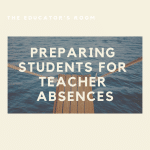Have you signed up for The Educator’s Room Daily Newsletter? Click here and support independent journalism!
It’s no surprise that teachers are burnt out. The only word that comes to mind is, “Duh.”
Recently, I have been thinking about teaching, pandemic notwithstanding, and how it got this way. How has this profession normalized working well after contract hours to lesson plan, grade, or serve on extra committees?
Burnt Out Teachers and Students
In my sixth year of teaching, I have slowly grown into a better work-life balance. But, I still feel like it is impossible to only work contractual hours if I want to get everything done. Sure, social media posts on pretty backgrounds reminding teachers to “Take your PTO!” and “Just say no” and “You’re still a great teacher if…” are great suggestions. But in actuality, I cannot possibly grade all my students’ essays between the last bell and quitting time. If I want an engaging lesson that fits my current students, I can’t just recycle old material in exactly the same way.
Many colleagues who complain about burnout also complain that students are “lazy.” In general, English teachers have seen a measurable decrease in the amount students are willing to read outside of class. Colleagues who have taught AP for years say they are shocked with how often students don’t read their assigned texts. A dozen years ago when I was in high school, I remember AP Lit being full of students like me; avid readers who wouldn’t dream of simply not doing the assigned reading. That’s no longer true.
“We need to make a shift and expect students to read outside class. It is what it is,” is a common sentiment. While I do think there’s merit in the argument that there is a fine line between support and coddling, and evidence suggests the internet is melting our brains, I also think that we are setting students up for burnout just as much as teachers.
We Need a New Approach
We have to reconsider our approach. I personally do not give homework. I plan for students to read in class, most often together. If they aren’t using class time well, they need to finish up at home. But, that’s their choice and never my goal. I’m starting to see parallels in what I want for my students and my colleagues.
I have many friends who are not in the teaching profession and it is a rarity that they work outside of their work hours. Sure, I’m painting with a broad brush, but working outside of work is absolutely expected for teachers.
Why do we normalize the response, “Sorry, I need to grade,” when a friend wants to go for a hike on a Saturday afternoon? Why does a student say “homework” in a Friday classroom circle when I ask what they are going to do to take care of themselves over the weekend? We need to end grind culture for both students and teachers.
Students and Teachers Need Lives Outside of School
Just as I want teachers to be able to “unplug” from school during evenings and weekends, I want students to go to baseball practice, have a family game night, and take a Sunday afternoon nap. We should all be able to enjoy those things without the stress of what we “should” be doing. If we assume students are lazy for not doing homework, are we also assuming teachers who don’t have a stellar lesson plan Monday morning are also lazy? Unfortunately, I’m afraid many of us might say, “Yes.”
Teachers Are Models for Students
Teachers know that our students are watching our every move. For better or worse, students notice everything from how we respond to a student’s behavior to the texts we decide to teach. What does our burnout show students to expect about the working world? Are we normalizing burnout for the next generation, just leading by example?
Making Teaching and Learning Sustainable
Teacher and student burnout are two sides of the same coin. If we want the teaching culture to reject working until we’re burnt out, we also need to reject the expectation that students should be stressed to the point of breaking down. I had a fleeting hope that we really would “reimagine education” in response to the COVID pandemic. Yet, we are right back to 51 minute periods, six subjects a day, bell to bell, tests, and homework. And, there are pieces of our system missing to support the current expectations. For example, teachers need common planning periods if we are expected to meaningfully analyze data. Students need study halls built into their day if we expect them to manage their current workload.
Teachers are burnt out, and so are our students. Ideally, I want to imagine a system that doesn’t need band aids of “extra time,” and actually works towards solutions of manageable expectations in the first place, for all of us. We all deserve a system that doesn’t perpetuate the cycle of burnout.
Editor’s Note: If you enjoyed this article, please become a Patreon supporter by clicking here.






